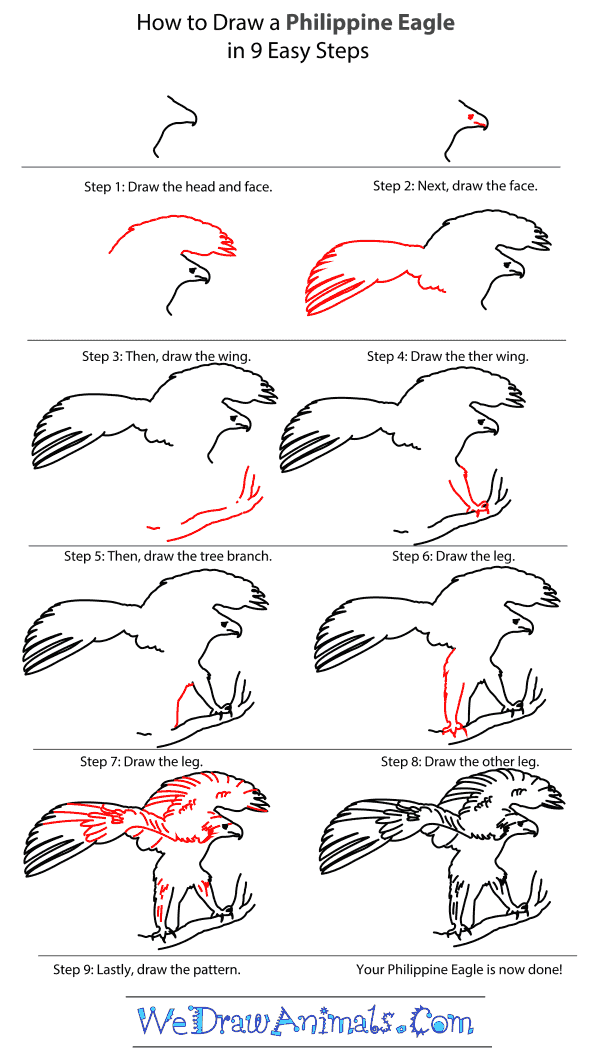In this quick tutorial you'll learn how to draw a Philippine Eagle in 9 easy steps - great for kids and novice artists.
The images above represent how your finished drawing is going to look and the steps involved.
Below are the individual steps - you can click on each one for a High Resolution printable PDF version.
At the bottom you can read some interesting facts about the Philippine Eagle.
Make sure you also check out any of the hundreds of drawing tutorials grouped by category.
How to Draw a Philippine Eagle - Step-by-Step Tutorial
Step 1: Draw the head and face. The top of the face is a short diagonal line down and to the right. It hooks down into a point. Then it continues back and down to the left.
Step 2: Next draw the mouth line. It is a line at the very bottom of the beak. There is a small eye at the end of that line.
Step 3: Starting at the top of the head line draw a curved line to the right. Draw several points as you bend the wing up and back to the left. Finish the top of the wing by curving it back and down.
Step 4: Continuing at the end of the first wing line start another wing line to the left. Curve it down gradually making long feathers along the line. Bend the bottom wing line back toward the body and draw a squiggly line back down to the right.
Step 5: Under the body draw two parallel lines to make a branch for the eagle to perch on.
Step 6: From the bottom of the body line draw a leg line down to the branch. Draw three claws or talons gripping the branch. Draw another leg line back up to the same height as the first.
Step 7: Draw the tail line on an angle from the top of the leg line to the branch.
Step 8: Continuing the wing line draw a jagged line down to the branch. Don't forget the talons gripping the branch. Draw another line back up to make the other leg line.
Step 9: Lastly, draw several short curved lines along the wings and legs. These make the feather patterns.
Interesting Facts about the PHILIPPINE EAGLE
The Philippine Eagle is a member of the bird group and the scientific term for them is Pithecophaga jefferyi. John Whitehead was the first person to discover and document this animal. The scientific name comes from the Greek word Pitheco-phaga (monkey-eater) and jefferyi (Jeffery) the founder’s father. Other common names for this species are the Great Philippine Eagle, Monkey-Eating Eagle, and King Bird.
Did you know?
- The animal was first documented in 1897.
- Their body length is up to almost 3.5 feet.
- Their wingspan can be over 7 feet wide.
- The weight of this species is up to almost 18 pounds.
- The weight of the monkeys they eat is over 20 pounds.
- Their age is up to 60 years.
- The punishment for killing this bird is 12 years in jail and a large monetary penalty.
This is the largest eagle in the world, and the national bird of the Philippines, where it lives in their forests. It is white with brown wings and a head with long blonde feathers. Their flight pattern is unique, fast and agile like a hawk. These animals have a low population amount, and are considered to be critically endangered to the possibility of extinction.










